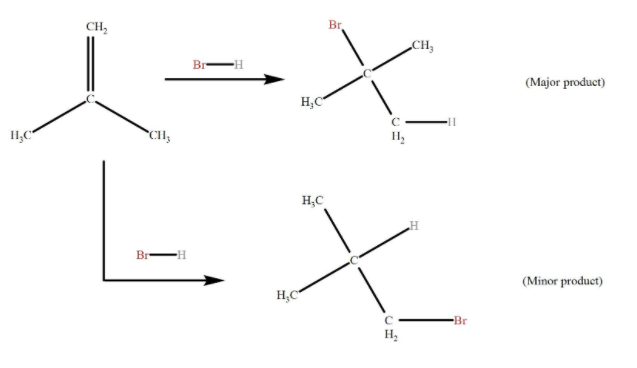
What is Markovnikov’s rule? Explain with an example.
Answer
431.2k+ views
Hint: We should know that Markovnikov’s rule is an empirical rule which is used to predict regioselectivity of electrophilic addition reaction of alkenes and alkynes. Keeping the purpose in mind, we need to describe the mechanism of Markovnikov's rule.
Complete step by step solution:
The Markovnikov’s rule states that with the addition of a protic acid HX to an asymmetric alkene, the acid hydrogen (H) gets attached to the carbon with more hydrogen substituents, and the halide (X) group gets attached to the carbon with more alkyl substituents.
Let us explain Markovnikov's rule with the help of a simple example.
When a protic acid HC (X = Cl, Br, I) is added to an asymmetrically substituted alkene, addition of acidic hydrogen takes place at the less substituted carbon atom of the double bond, while X is added to the more alkyl substituted carbon atom. In other words, hydrogen is added to the carbon atom with more number of hydrogen atoms attached to it and halide is added to the carbon with the least number of hydrogen atoms.
We should know that the driving force behind the reaction is the formation of carbocation in addition of H to the alkene, in the first step of the reaction. The most stable carbocation is formed when H is added to carbon having more number of hydrogen atoms already attached, due to factors like induction and hyperconjugation, which gives the major product with Br added to less hydrogen rich carbon.
Less stable carbocation (H added to less hydrogen rich carbon) is also present in small quantities, forming minor products in addition to Br to carbon having more hydrogen attached.

Note: There are various practical applications of Markovnikov’s rule. Some of them are Halohydrin formation (in alcohol and water), Oxymercurationand Demercuration and Acid catalysed hydration. These reactions are the laboratory usages of Markovnikov’s rule and are used in a variety of chemical processes.
Complete step by step solution:
The Markovnikov’s rule states that with the addition of a protic acid HX to an asymmetric alkene, the acid hydrogen (H) gets attached to the carbon with more hydrogen substituents, and the halide (X) group gets attached to the carbon with more alkyl substituents.
Let us explain Markovnikov's rule with the help of a simple example.
When a protic acid HC (X = Cl, Br, I) is added to an asymmetrically substituted alkene, addition of acidic hydrogen takes place at the less substituted carbon atom of the double bond, while X is added to the more alkyl substituted carbon atom. In other words, hydrogen is added to the carbon atom with more number of hydrogen atoms attached to it and halide is added to the carbon with the least number of hydrogen atoms.
We should know that the driving force behind the reaction is the formation of carbocation in addition of H to the alkene, in the first step of the reaction. The most stable carbocation is formed when H is added to carbon having more number of hydrogen atoms already attached, due to factors like induction and hyperconjugation, which gives the major product with Br added to less hydrogen rich carbon.
Less stable carbocation (H added to less hydrogen rich carbon) is also present in small quantities, forming minor products in addition to Br to carbon having more hydrogen attached.

Note: There are various practical applications of Markovnikov’s rule. Some of them are Halohydrin formation (in alcohol and water), Oxymercurationand Demercuration and Acid catalysed hydration. These reactions are the laboratory usages of Markovnikov’s rule and are used in a variety of chemical processes.
Recently Updated Pages
How to find Oxidation Number - Important Concepts for JEE

How Electromagnetic Waves are Formed - Important Concepts for JEE

Electrical Resistance - Important Concepts and Tips for JEE

Average Atomic Mass - Important Concepts and Tips for JEE

Chemical Equation - Important Concepts and Tips for JEE

Concept of CP and CV of Gas - Important Concepts and Tips for JEE

Trending doubts
JEE Main 2025 Session 2: Application Form (Out), Exam Dates (Released), Eligibility, & More

JEE Main 2025: Derivation of Equation of Trajectory in Physics

Learn About Angle Of Deviation In Prism: JEE Main Physics 2025

Number of sigma and pi bonds in C2 molecule isare A class 11 chemistry JEE_Main

Electric Field Due to Uniformly Charged Ring for JEE Main 2025 - Formula and Derivation

JEE Main 2025: Conversion of Galvanometer Into Ammeter And Voltmeter in Physics

Other Pages
NCERT Solutions for Class 11 Chemistry Chapter 9 Hydrocarbons

NCERT Solutions for Class 11 Chemistry Chapter 7 Redox Reaction

JEE Advanced Marks vs Ranks 2025: Understanding Category-wise Qualifying Marks and Previous Year Cut-offs

NCERT Solutions for Class 11 Chemistry Chapter 5 Thermodynamics

Hydrocarbons Class 11 Notes: CBSE Chemistry Chapter 9

NCERT Solutions for Class 11 Chemistry In Hindi Chapter 1 Some Basic Concepts of Chemistry




